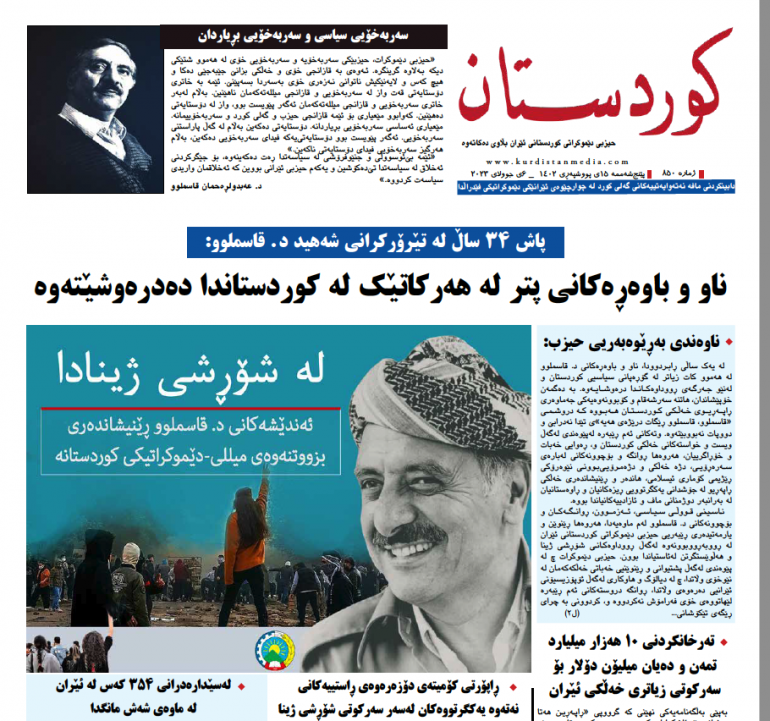On the 34th anniversary of the assassination of Abdulrahman Ghassemlou, Secretary General of the Democratic Party of Iranian Kurdistan (PDKI), three members of the Iranian opposition party were killed within several days in the Kurdistan Region of Iraq. These latest deaths, deemed ‘assassinations’, came in the wake of explicit warnings from Tehran for Iranian Kurdish opposition groups to disarm and move to refugee camps.
In recent months, amid growing concerns over the revitalized opposition support triggered by mass protests following the death of a young Kurdish woman in police custody last September, Tehran has escalated its crackdown on these groups. This suppression has not only been enforced domestically but has also extended to neighboring Iraq and even Europe, with numerous reports of Iran targeting its opposition.
Within the Kurdistan Region of Iraq, the Iranian Revolutionary Guard Corps (IRGC) has been intensely active, pounding the bases of these oppositions, pressuring on Baghdad and Erbil to curtail the activities of their fighters, secure the border between the two countries, and has been implicated in a series of recent assassinations.
‘Political assassinations’
On Tuesday, Siamand Shaboi, a member of the KDPI, vanished in Erbil. His family and relatives reported his disappearance to the authorities, who discovered his body the following day at a construction site on the outskirts of Erbil. According to the Norway-based Hengaw NGO, which monitors human rights violations by Tehran, Shaboi had multiple gunshot wounds to his back.
Hengaw reported that Shaboi had been threatened by the Iranian regime on numerous occasions. Earlier, KDPI members Luqman Aji and Adel Muhajir were killed in a tourist area in the Qaladze district of Sulaymaniyah province. Another individual, Sadi Muradpour, was critically injured. Hengaw suggested that the perpetrator was an Iranian agent who had fled the Kurdistan Region following the killings.
In a recent tweet, Hengaw insinuated that members of the Iranian Revolutionary Guard Corps (IRGC) and its subgroups, including the Saberin unit, had entered the Kurdistan Region in recent weeks under the guise of businesspeople. The statement hinted at their potential involvement in the killings of Iranian opposition members.
These events coincide with a recent warning from Major General Mohammad Hossein Baqeri, Iran’s Armed Forces Chief of Staff, who indicated that Iran might act against Kurdish opposition groups in Iraq if the Iraqi government fails to comply with a disarmament agreement by September. On March 19, Ali Shamkhani, Secretary of Iran’s Supreme National Security Council, and his Iraqi counterpart Qasim al-Araji signed a border security agreement intended to significantly restrict the activities of opposition groups based in the Kurdistan Region. Following the agreement, al-Araji met with Ali Akbar Ahmadian, his newly elected counterpart, along with KDP’s Minister of Interior Rebar Ahmed, and the PUK’s Head of Assayish Agency, Hiwa Ahmed.
Bafel Talabani, the leader of the Patriotic Union of Kurdistan (PUK), stated on Tuesday in London that he has no doubt that Tehran will follow through with its threats to attack Iranian opposition groups if they fail to comply with its demands.
Meanwhile, the IRGC has announced that it is using heavy artillery and drone strikes in the Kurdistan province, bordering Kermanshah, in an effort to eliminate fighters from the Kurdistan Free Life Party (PJAK), an offshoot of the Kurdistan Workers’ Party (PKK). The IRGC is focusing its attacks on the Kosalan region in Hawraman near Mariwan, which borders Iraq’s Kurdistan Region. Although past attempts to secure control over the Kosalan range have been unsuccessful, the IRGC is now stating its unwavering commitment to its capture.
The anti-government protests that rapidly swept the nation following Jina Amini’s death in September may not have transformed Tehran’s authoritarian Islamist government, but they certainly pose the most significant threat to its power since its establishment in 1979. This is likely why Tehran seems to have realized that it cannot afford to ignore the presence and growth of its opposition groups, wherever they may be located.


